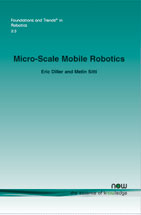Micro-Scale Mobile Robotics
By Eric Diller, Carnegie Mellon University, NanoRobotics Lab, Department of Mechanical Engineering, USA, ediller@cmu.edu | Metin Sitti, Carnegie Mellon University, NanoRobotics Lab, Department of Mechanical Engineering, USA, sitti@cmu.edu
Abstract
The field of microrobotics has seen tremendous advances in recent years. The principles governing the design of such submillimeter scale robots rely on an understanding of microscale physics, fabrication, and novel control strategies. This monograph provides a tutorial on the relevant physical phenomena governing the operation and design of microrobots, as well as a survey of existing approaches to microrobot design and control. It also provides a detailed practical overview of actuation and control methods that are commonly used to remotely power these designs, as well as a discussion of possible future research directions. Potential high-impact applications of untethered microrobots such as minimally invasive diagnosis and treatment inside the human body, biological studies or bioengineering, microfluidics, desktop micromanufacturing, and mobile sensor networks for environmental and health monitoring are reported.
Micro-Scale Mobile Robotics
The field of microrobotics has seen tremendous advances in recent years. The principles governing the design of such sub-millimeter scale robots rely on an understanding of microscale physics, fabrication, and novel control strategies.
Micro-Scale Mobile Robotics provides a tutorial on the relevant physical phenomena governing the operation and design of microrobots, as well as a survey of existing approaches to microrobot design and control. It also provides a detailed practical overview of actuation and control methods that are commonly used to remotely power these designs, as well as a discussion of possible future research directions. Potential high-impact applications of untethered microrobots such as minimally invasive diagnosis and treatment inside the human body, biological studies or bioengineering, microfluidics, desktop micro-manufacturing, and mobile sensor networks for environmental and health monitoring are also discussed.
Micro-Scale Mobile Robotics is an ideal reference for those designing future microrobot technologies. While the review is not intended to be completely comprehensive in every area, it does expose the reader to the novel approaches used thus far for microrobot motion, manipulation, and other tasks. The rapid pace of development in the field is exciting, and this text concludes with a look forward at some of the challenges that remain.
